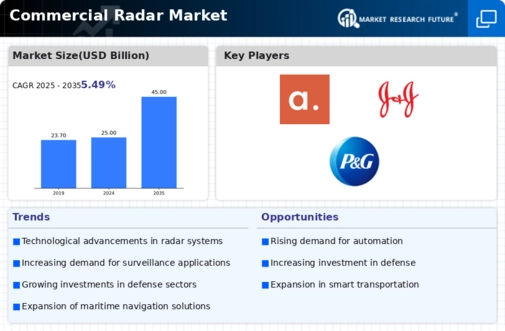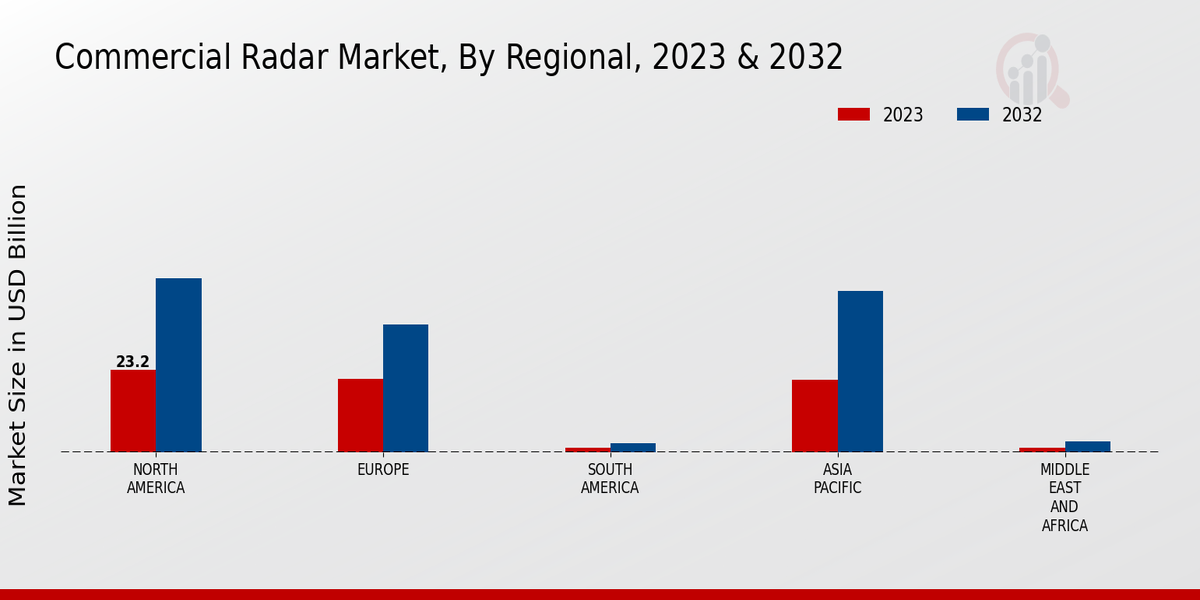Market Growth Projections
The Global Commercial Radar Market Industry is poised for substantial growth, with projections indicating an increase from 25 USD Billion in 2024 to 45 USD Billion by 2035. This growth trajectory suggests a compound annual growth rate of 5.49% from 2025 to 2035. The expansion is driven by various factors, including technological advancements, increasing demand for surveillance, and the rise of autonomous vehicles. These elements collectively contribute to a robust market environment, indicating a promising future for radar technologies across multiple sectors. The anticipated growth underscores the strategic importance of radar systems in modern applications.
Technological Advancements
The Global Commercial Radar Market Industry is experiencing rapid technological advancements that enhance radar capabilities. Innovations such as phased array radar systems and synthetic aperture radar are improving detection accuracy and range. These advancements are crucial for various applications, including aviation, maritime, and defense sectors. As technology evolves, the market is projected to grow from 25 USD Billion in 2024 to 45 USD Billion by 2035, reflecting a compound annual growth rate of 5.49% from 2025 to 2035. This growth is indicative of the increasing reliance on sophisticated radar systems for surveillance and monitoring.
Growing Demand for Surveillance
The demand for enhanced surveillance systems is a significant driver in the Global Commercial Radar Market Industry. Governments and private sectors are investing in radar technologies to bolster national security and protect critical infrastructure. For instance, countries are deploying advanced radar systems for border security and maritime surveillance. This trend is expected to contribute to the market's expansion, with projections indicating a growth from 25 USD Billion in 2024 to 45 USD Billion by 2035. The increasing need for real-time data and situational awareness further underscores the importance of radar systems in contemporary security frameworks.
Environmental Monitoring and Management
Environmental monitoring is becoming increasingly vital, driving growth in the Global Commercial Radar Market Industry. Radar systems are utilized for various applications, including weather forecasting, climate change studies, and disaster management. These technologies provide critical data for assessing environmental conditions and responding to natural disasters. As governments and organizations prioritize sustainability and environmental protection, the demand for radar systems is expected to rise. The market is projected to expand from 25 USD Billion in 2024 to 45 USD Billion by 2035, reflecting a CAGR of 5.49% from 2025 to 2035, highlighting the role of radar in addressing environmental challenges.
Expansion of Aerospace and Defense Sectors
The aerospace and defense sectors are pivotal to the Global Commercial Radar Market Industry, driving demand for advanced radar systems. With the rise in military expenditures and the modernization of defense capabilities, there is a growing need for sophisticated radar technologies. Countries are investing in next-generation radar systems for air traffic control, missile detection, and reconnaissance missions. This sector's growth is anticipated to propel the market from 25 USD Billion in 2024 to 45 USD Billion by 2035, with a CAGR of 5.49% from 2025 to 2035, reflecting the strategic importance of radar in national defense.
Increasing Adoption of Autonomous Vehicles
The rise of autonomous vehicles is significantly influencing the Global Commercial Radar Market Industry. As manufacturers integrate radar systems for navigation and obstacle detection, the demand for reliable radar technology is surging. This trend is evident in the automotive sector, where radar plays a crucial role in enhancing safety features and enabling autonomous driving capabilities. The market is expected to grow from 25 USD Billion in 2024 to 45 USD Billion by 2035, with a CAGR of 5.49% from 2025 to 2035. The integration of radar in vehicles is likely to reshape transportation dynamics and safety standards.





